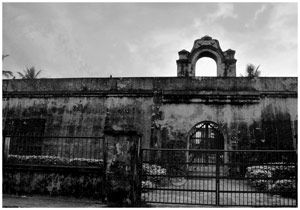Intolerance on the part of the Dutch at the rise of the English.
The French attacks the Dutch.
The courageous fight of William III.
The Dutch tightens their rule over Cochin.

1695
The English Fort at Anjengo Disturbs the Peace of Mind of the Dutch
When the Dutch were running around to take in to their hands the trade in Malabar (Kerala), great events were happening in India and the world.
The Mughal Empire was being expanded by the conquest of the east and west of India, the Deccan (south) and so on. It was during this period that the Maratha power rose under the leadership of Shivaji and that the Sikhs established a movement called Khalsa against the religious policies of Aurangazeb. The dispute between the king and the yogakkar, the administrative body, as well as ooralars of Sree Padmanabha temple further worsened. The joining in hands of the madambis, the traditional lords, and pillamars who were the keepers of the temple properties turned out to be a threat to the king.

The eventful life of Shivaji came to an end in 1680. This was a great opportunity for Aurangazeb who was awaiting opportunities to crush the Maratha power. With the capture of Cochin by the Dutch, the English was expelled from there and their expansion of trade in Ponnani did not secure any progress. The British, in the meanwhile, approached the Queen of Attingal and secured permission to construct a fort in Anjengo.

It was a period when science and literature had achieved progress.The priestocracy frowned at the discovery of Issac Newton's Laws of Motion. The bloodless Glorious Revolution of England was another historical event. The Protestants of England revolting against the absolutism of James II and their invitation of William and his wife Mary who was the daughter of the king to England to rule it and the subsequent fleeing of James to France marked the events. Peter, the Great, started his rule in Russia in the following year.

When all these took place the Dutch were tightening their grip on the administration of Cochin. Though Cochin came under the rule of the Dutch, the hostility between the Zamorin and the king of Cochin had not attenuated. The two countries flared up intermittently. In the meanwhile the decision to adopt some from the Pazhoor branch of royalty to the royal family of Cochin paved the way for civil war. Chieftains who opposed the adoption resolved to fight against the king demanding that the adoption should be from Vettathu Nadu branch of Cochin royalty. The disputation changed into a fierce war. The scheming Zamorin did not lose the opportunity .He came to the help of Cochin along with the Dutch. Known as Vettam War of succession, the flare-up ended with the Zamorin being given away the areas of Chettuva by the Dutch whose aims were to establish trade relations with him and to alienate him from the British.Though the king had displeasure at the annexation of Chettuva, afraid of the Dutch he remained mute for time being. Even after this, the friction between the king and the Zamorin continued.
The construction of the fort by the British at Anjengo was progressing fast. It was a step that disturbed the peace of mind of the Dutch. The Dutch estimated that if the fort was completed it would be biggest trade centre of the British in Kerala. But they were not ready for an attack on the fort. The fort of Anjengo was completed in 1695.As apprehended by the Dutch, the fort turned out to be the lucky door for the English East India Company.